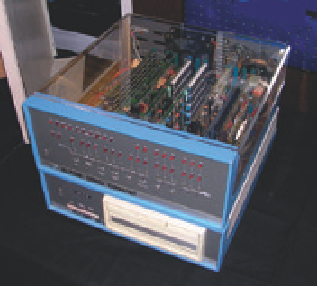Information Technology Reference
In-Depth Information
important because it would allow hobbyists and other electronics companies
to make cards for the Altair. In spite of the fact that no peripheral cards were
available for many months after launch, and there was no prepackaged soft-
ware available for the machine, customers deluged MITS with orders for the
Altair. But the machine was far from being a household item: to get the Altair
to actually do anything, a user had to painstakingly enter a program by hand,
bit by bit, using toggle switches on the front panel. It was clear from the time
of its launch that what the Altair urgently needed was the capability to run a
high-level programming language.
The BASIC programming language was developed in the 1960s by John
Kemeny and Thomas Kurtz at Dartmouth College. BASIC is an acronym for
Beginner's All-purpose Symbolic Instruction Code, and the language was used
at Dartmouth for teaching undergraduates. A team of engineers at Digital
Equipment Corporation (DEC) had taken an important step in the evolution of
BASIC in 1971. They used BASIC to implement a new operating system for the
PDP-11 minicomputer, and they extended and modified the language in a num-
ber of important ways. The most important was the introduction of “PEEK” and
“POKE” commands, which gave programmers the ability to execute low-level sys-
tem calls, and to interact with the computer's memory at the byte level directly
from a BASIC program. The engineers also made some compromises to the orig-
inal rules of the language, changes disapproved of by Kemeny and Kurtz, that
allowed DEC BASIC to be used on machines with very limited memory. Despite
its ease of use, academic computer science departments often discouraged BASIC
as a teaching language because it was believed to encourage bad programming
habits. Edsger Djikstra, who received the Turing Award for his contributions to
computing, went so far as to say that programming in BASIC causes brain dam-
age (see
B.4.11
). For the personal computing revolution, BASIC, with the DEC
extensions allowing programmers to pass easily from BASIC to machine code,
was the obvious first choice. Ed Roberts said that he had settled on BASIC for the
Altair because you “could teach any idiot how to use [it] in no time at all.”
7
Paul Allen and his friend from high school, Bill Gates, had been entranced
by computers from their days at Lakeside School, a private school in Seattle
(
B.8.1
). In their spare time, they had worked as testers for the C-Cubed computer
Fig. 8.5. The MITS Altair 8800. Most
do-it-yourself hobbyists did not want to
have to buy all the integrated circuits
and other components needed to build
the computer. The appeal of the Altair
8800 was that it was the first build-your-
own-computer kit.
B.8.1. The photograph shows Paul Allen at a teletype and Bill Gates (standing) when they were at
Lakeside School in Seattle in 1968. Allen and Gates had signed up for the school's independent
study option on programming and learned to program in BASIC. The two became captivated by
computing and spent many hours of their spare time working for a local computer company. As
a result of this experience, they became proficient in operating system software and assembly
language for the PDP-10. The appearance of the Altair do-it-yourself computer kit on the cover
of the magazine
Popular Electronics
in January 1975 excited Allen and Gates. They contacted Ed
Roberts, the designer of the Altair, and offered to produce a BASIC interpreter for the machine.
Remarkably, they had no access to an Altair machine when they wrote their interpreter. Instead,
they debugged their BASIC interpreter using a simulator of the Intel 8080 microprocessor that
Allen wrote for the PDP-10 that Gates had access to at Harvard. Aided by fellow Harvard student
Monte Davidoff, the three of them finished their BASIC interpreter in just eight weeks. When
Harvard reviewed the usage statistics of their PDP-10 machine during January, they found that
William Henry Gates III had used a surprisingly large amount of computer time!


Search WWH ::

Custom Search